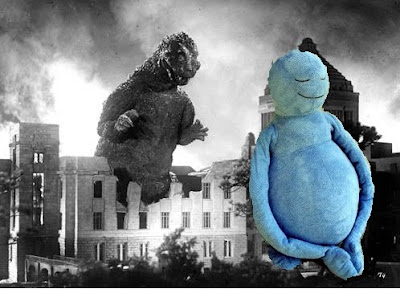






 I hope this is a convincing enough reconstruction of Ophiacodon's unusual lifestyle based on as much evedence as I could find. Next time I will be exploring more relatives of the Gorgons, possibly the poisonous Therocephalians.
I hope this is a convincing enough reconstruction of Ophiacodon's unusual lifestyle based on as much evedence as I could find. Next time I will be exploring more relatives of the Gorgons, possibly the poisonous Therocephalians. 






 I hope this is a convincing enough reconstruction of Ophiacodon's unusual lifestyle based on as much evedence as I could find. Next time I will be exploring more relatives of the Gorgons, possibly the poisonous Therocephalians.
I hope this is a convincing enough reconstruction of Ophiacodon's unusual lifestyle based on as much evedence as I could find. Next time I will be exploring more relatives of the Gorgons, possibly the poisonous Therocephalians. 

 Above: In an attempt to warn the public I am placing these signs in all known manatee hunting grounds.
Above: In an attempt to warn the public I am placing these signs in all known manatee hunting grounds. Above you can see the classic manatee hunting strategy. In the centre of the picture one manatee distracts the unwary snorkeler. Meanwhile in the bottom left of the photo you can see a second manatee sneaking up from behind to engulf its prey!
Above you can see the classic manatee hunting strategy. In the centre of the picture one manatee distracts the unwary snorkeler. Meanwhile in the bottom left of the photo you can see a second manatee sneaking up from behind to engulf its prey!



And that is all we need to know has happened this year.




Above; a Gorgon attacks a Parieasaur.




 Truthfully the Japanese film companies ran out of good ideas a long time ago, but this has all changed with the new blockbuster; Godzilla vs the Therapy buddies.
Truthfully the Japanese film companies ran out of good ideas a long time ago, but this has all changed with the new blockbuster; Godzilla vs the Therapy buddies.
 I have been forced by the government of the United Kingdom (god bless e'm) to warn you of a new issue of national concern that is affecting everyone in the country.
I have been forced by the government of the United Kingdom (god bless e'm) to warn you of a new issue of national concern that is affecting everyone in the country.




 Above: The therapy buddies killing Kopelle, using the power of 20 soothing messages to explode his brain with love and gentleness.
Above: The therapy buddies killing Kopelle, using the power of 20 soothing messages to explode his brain with love and gentleness.
The therapy buddies have used their time travelling abilities to go back in time and bring back some Raptors. Then they used their soft and gentle voice to coress and hypnotize the dinosaurs into obeying their treacherous commands. Unfortunately the buddies hypnotic powers were too weak for the dinosaurs and they rebelled, eating all of the therapy buddies and automatically destroying their time machine, whizzing them back to the Jurassic.
Since the dinosaurs rebelled, the buddies have needed Kopelle's help yet again. Using a sample of his DNA the therapy buddies have successfully created a clone of Kopelle. He is called Richard Kopelle 2! Above: Bearded beware; for you are the buddies next targets.
Above: Bearded beware; for you are the buddies next targets.To be honest Velociraptor was a pussy. It was the size of a turkey for goodness sake. Deinonychus and especially Utahraptor were the true predators. Utahraptor had a killing claw 24cm long!
Utahraptor was one of the earliest of the Raptors, living 120 million years ago in the early Cretaceous period of North America.
 Unlike other Raptors Utahraptor had much thicker legs that were more robust. This suggests that Utahraptor was very powerfully built, unable to run fast, but well adapted take down large slow moving prey. The leg bones were even twice as thick as those of Allosaurus, an animal twice the size of Utahraptor.
Unlike other Raptors Utahraptor had much thicker legs that were more robust. This suggests that Utahraptor was very powerfully built, unable to run fast, but well adapted take down large slow moving prey. The leg bones were even twice as thick as those of Allosaurus, an animal twice the size of Utahraptor. Utahraptor was probably a predator of the large long necked Brachiosaurs , using its massively powerful legs to leap at its prey, clinging onto its back and inflicting deep wounds with its killing claws as it used them to grip onto the animals flanks.
So why is Utahraptor the Jurassic Albatross mascott? Well for starters it had feathers. Raptors from China have been found with feathers preserved on their bodies, suggesting Utahraptor had them too. Therefore it fits in with the albatross/ bird catergory. Also because it is prehistoric, as the word Jurassic suggests. Finally because Raptors are cool and Utahraptor is the biggest. I will prepare a suitable image right away.






